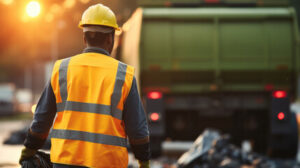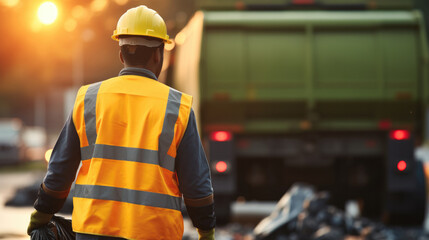Rubbish Collection Armadale involves removing waste from homes and businesses. This waste is then transported to a disposal site where it is sorted and sent for recycling or landfill.
Some cities have a rubbish collection system that requires residents to bring their waste out for collection by laborers. This can be inconvenient for some people and maybe a problem for those with cultural beliefs or security concerns that prevent laborers from entering their property.

Rubbish is a term used to describe unwanted things or waste material, such as old food. It is usually thrown away and collected by rubbish collectors, who take it to a dump. It is also used to describe something that is of low quality, such as a piece of writing or art. You can also use the word to criticize someone or something strongly. For example, you could say that the book you read was rubbish or that the idea you had for your thesis is a load of rubbish.
The word “rubbish” refers to undesired items or garbage, including spoiled food. Usually, it is thrown out and picked up by garbage collectors, who then transport it to a landfill. It can also be used to characterize something that is poorly done, like a piece of writing or artwork. The word can also be used to harshly condemn someone or something. You may claim, for instance, that the book you read was garbage or that the thesis concept you came up with was absurd.
The word rubbish is used in many different languages. For example, in British English, the word rubbish is often pronounced as rubbish. The word is similar to other words that mean the same thing, such as balderdash and bosh. It is also used in other countries with different spellings, such as rubbish
While the terms garbage and trash are sometimes used interchangeably, there is an important difference between them. Garbage is mostly organic, while rubbish is not. It is also a more general term than trash, which may refer to specific items, such as old electronics or plastic bags.
It is important to separate non-biodegradable rubbish from other types of waste because it can take hundreds of years to break down and can damage ecosystems and kill wildlife. Biodegradable rubbish, such as food and paper, can be broken down into smaller pieces to be used as compost or recycled, which helps to reduce the amount of rubbish that is sent to landfills.
Rubbish is also a verb that means to criticize someone or something strongly. For instance, you can say that someone’s ideas are rubbish or that they did a bad job at their job. You can also use the word to describe something that is nonsense or untrue, such as saying that Winston Churchill was an alien sent from another planet to fix World War II. This usage is common in British and Australian English.
Waste collection is a municipal service delivered either by the local authority or privately-contracted waste management companies. The collection process varies across the country and is determined by what policies have been implemented in the individual municipality, which could include what can be recycled and when rubbish is collected.
A grey bin is used to collect rubbish that can’t be recycled, including nappy and food scraps, and is usually collected every two weeks (with a four-week break over Christmas). Reduce the pressure on your grey bin by maximising the materials you recycle in your blue and brown bins. You can also help to ease the burden on your grey bin by putting out your rubbish for collection at least 6pm the night before and by 6am on your collection day. This will ensure that your rubbish is fully emptied and helps to reduce the risk of pests getting into your bin.
Many councils offer weekly or fortnightly rubbish collections for non-recyclable waste, along with separate recycling bins. Depending on the type of waste, it may be transported to a landfill, incinerator or recycling plant. Landfills are the most common destination for non-recyclable waste, with more than 70% of rubbish in the ending up in landfill.
In the past, urban waste was disposed of by dumping it in unusable areas or by throwing it in places like rivers and canals, where it would be carried away by water currents. More recently, the use of large lorries with trailers to collect and transport rubbish has become more common. These vehicles can carry large volumes of waste and are usually driven by a single driver.
In the garbage collection is mostly a municipal responsibility. The largest cities fund their waste management through general city revenues rather than charging residents separately for trash disposal. In this means the city’s Sanitation Department is able to operate on a huge scale without having to charge residents directly for their trash removal. Unfortunately, the city still lags behind other municipalities when it comes to modern rubbish collection and disposal methods.
The rubbish you toss into the bin goes on a journey that stretches across the city, state or country. It might make a few stops along the way, as it gets sorted and prepared for its eventual destination. Where it ends up depends on what you put in your bins, and what sort of recycling program your local government has in place. The produces a disproportionate share of the world’s garbage, but many cities are able to recycle more than they send to landfills.
Trash is often sent to a waste treatment facility, where it will undergo processing, and a portion of it may be incinerated for energy, or recycled. The rest of it is stored in a landfill or buried underground. Most of this trash is called municipal solid waste (MSW).
In the past, people dumped their rubbish in open pits, where it was burned to create energy. This produced toxic smoke that caused respiratory problems, and it polluted the groundwater. In the early 1900s, it became clear that something had to be done.
Today, we transport our trash to landfills by a system of trucks and railcars that are operated by a network of public and private companies. The tangle of handlers, machines, transfers and forms of transportation consume a lot of energy, and produce emissions.
Once garbage is transported to a transfer station, it is loaded into larger trucks for the trip to its final destination. A transfer station is a node in the ceaseless machine that moves garbage. Its 7,200 sanitation workers and 2,100 trucks crisscross the city every day, handling 12,000 tons of trash, including food waste and discarded clothing.
When it arrives at a landfill, heavy equipment compacts the rubbish into areas called cells. Each cell is designed to hold a day’s worth of garbage. It is covered with a layer of soil, and the bottom layer of the cell is lined with an impermeable liner to prevent rainwater from seeping through to the trash. The trash is broken down by bacteria in the absence of oxygen, a process known as anaerobic decomposition. This produces methane, a greenhouse gas that is 28 to 36 times more potent than carbon dioxide.
Many items that don’t fit into your green bin for recycling, brown food and garden waste bin, or blue crate for glass go in the black general household waste bin. But this bin shouldn’t be used as a catch-all for any waste that can’t be disposed of using your other bins, as doing so will ruin entire batches of recycling and cause unnecessary harm to the environment.
If you are unsure whether something should go in your rubbish bin or another colour bin, find out more about our different bins and what can and cannot be placed in them. This will help you to avoid putting the wrong items in your bin, and ensure that it’s collected on the correct day. This will also help to reduce waste sent to landfill and increase the amount of recycling you can do.
